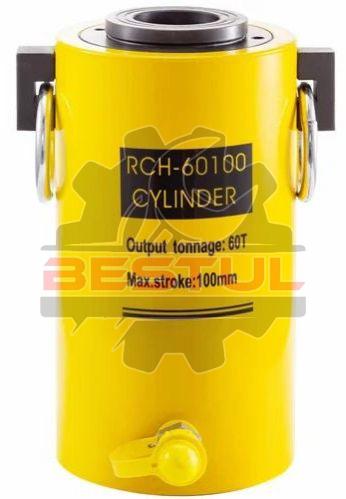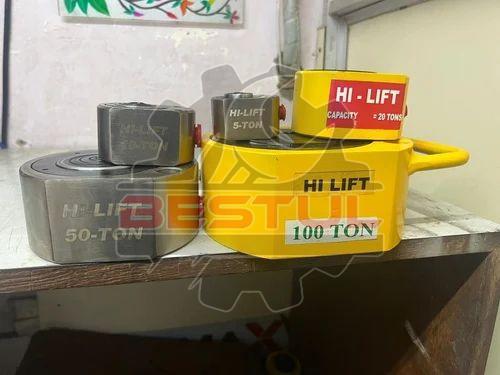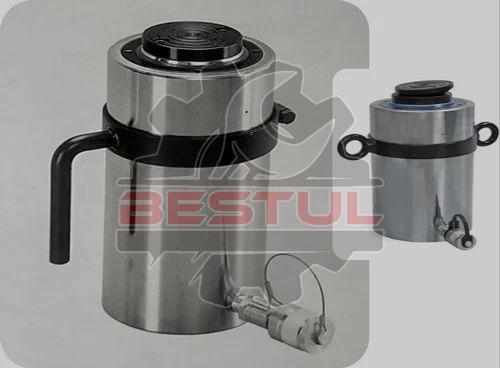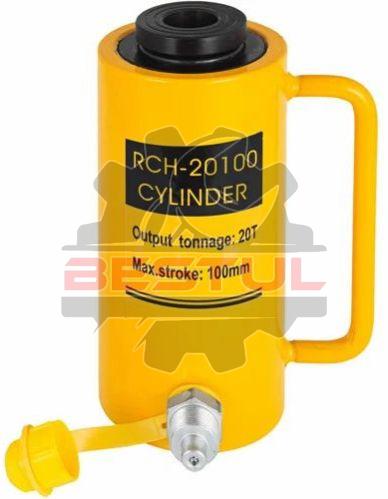Industrial Cylinders
Leading Exporters, Wholesaler, Manufacturers, Importer and Trader of 100mm Hydraulic Jack Hollow Single Acting Ram Lifting Cylinder, Button Hydraulic Jacks - Low Height Cylinder, Double Acting Plain Ram Cylinder and Single Acting Hollow Plunger Hydraulic Cylinder from Mumbai.
| Business Type | Exporter, Supplier |
| Material | MildSteel,EN-19 |
| Automatic Grade | Semi-Automatic |
| Feature | Easy To Operate, Optimum Finish |
| Country of Origin | Made in India |
| Capacity | 60 Ton |
| Working Pressure | 700 BAR |
A single-acting hollow plunger hydraulic cylinder is a type of hydraulic actuator that uses fluid pressure to extend the plunger while relying on an external force, like gravity or a spring, to retract it. Here are some key features and characteristics:
Design
- Hollow Plunger: The plunger is hollow, allowing for other components, such as rods or tools, to be inserted or operated through it.
- Single-Acting: It operates in one direction; hydraulic fluid is applied to one side of the piston to extend it, and the retraction happens due to an external force.
Operation
- Extension: When hydraulic fluid is pumped into the cylinder, it creates pressure that pushes the plunger outwards.
- Retraction: Once the pressure is released, the plunger returns to its original position through external forces.
Applications
- Lifting and Positioning: Commonly used in applications where lifting or positioning is required, such as in construction, manufacturing, and material handling.
- Mold Opening/Closing: Often used in die-casting or molding processes.
Advantages
- Simplicity: Fewer components compared to double-acting cylinders, which can mean easier maintenance.
- Cost-Effective: Generally more affordable due to their simpler design.
Disadvantages
- Limited Force in One Direction: Only provides power in one direction, requiring additional mechanisms for retraction.
- Dependency on External Forces: The efficiency of operation can depend on gravity or springs.
-
Hollow Design: The hollow center allows for easy access to the interior, which can be beneficial for certain applications, like threading tools or rods through the cylinder.
-
Piston Mechanism: The piston within the cylinder is designed to handle high pressures while minimizing friction. This ensures smooth operation during extension.
-
Seals: Effective sealing is crucial to prevent hydraulic fluid leakage. Seals are typically designed to withstand high pressures and environmental conditions.
-
Mounting Options: Many cylinders come with various mounting configurations, allowing for flexible installation in different setups.
Advantages
-
Space Efficiency: The hollow design can save space and allow for more compact machinery setups.
-
Less Complexity: With fewer moving parts, single-acting cylinders can be easier to troubleshoot and repair.
-
Weight Reduction: They are generally lighter than double-acting cylinders, which can be a significant factor in mobile applications.
-
Cost-Effective: Lower initial investment and maintenance costs compared to more complex hydraulic systems.
Limitations
-
Retracting Mechanism: Since retraction relies on external forces, systems must be designed to ensure these forces are sufficient, which can complicate design.
-
Power Limitations: They may not be suitable for applications requiring high retraction forces, as the hydraulic system can only provide power for extension.
-
Fluid Dependency: Performance can be affected by fluid viscosity and temperature; proper fluid selection and maintenance are necessary.
Typical Applications
-
Construction Equipment: Used in jacks and lifts for raising heavy loads, where gravity assists in retraction.
-
Manufacturing: Common in automation processes where items need to be pushed or pulled with precision.
-
Automotive Repair: Hydraulic jacks utilize single-acting cylinders to lift vehicles safely.
| Business Type | Exporter, Supplier |
| Capacity | 50 Ton |
| Application | Industrial |
| Material | EN-19 |
| Operating Mode | Manual |
| Max Operating Torque | 700 Bar Working Pressure |
| Country of Origin | Made in India |
Button Hydraulic Jacks – Low Height Cylinder are specialized hydraulic lifting devices designed with a low profile (short height) and high lifting capacity, typically used for applications where there is limited clearance or where a more compact lifting solution is required. These jacks combine the power of hydraulics with a unique "button" shape and low height, which makes them especially suitable for low-clearance applications.
Overview of Button Hydraulic Jacks (Low Height Cylinder)
The "button" refers to the jack’s unique low-profile design, which provides a short overall height compared to traditional jacks. These jacks are often referred to as low-profile hydraulic jacks or short stroke hydraulic jacks, and they are particularly valuable when lifting heavy loads in confined spaces.
Key Features of Button Hydraulic Jacks (Low Height Cylinder)
-
Low Profile Design:
- Short Height: These jacks are designed to be extremely compact in height, making them ideal for lifting vehicles, machinery, or other equipment in situations where traditional jacks would not fit due to limited clearance.
- The low height allows them to be placed underneath low-clearance vehicles or machinery for lifting tasks that require precise lifting in tight spaces.
-
High Lifting Capacity:
- Despite their low height, these jacks can provide significant lifting power, often ranging from 2 tons to 100 tons or more, depending on the model and its intended application.
- Hydraulic jacks are known for their ability to lift much heavier loads than mechanical jacks of a similar size.
-
Button-Shaped Cylinder:
- The "button" shape refers to the unique design of the hydraulic cylinder, which is usually shorter in length and wider in diameter compared to conventional models. This allows for more stability and strength while maintaining a compact footprint.
-
Hydraulic System:
- The hydraulic system in these jacks uses fluid under pressure to generate lifting force. A hand or electric pump supplies the pressure to the cylinder, causing the piston inside to extend and lift the load.
- The use of hydraulic force allows these jacks to lift significantly heavier loads compared to mechanical jacks.
-
Sealed and Durable Construction:
- These jacks are built with high-quality materials and seals that prevent fluid leakage, ensuring durability and long-lasting performance.
- They are also resistant to wear and tear, making them suitable for industrial, automotive, and construction environments.
-
Safety Features:
- Overload Protection: Button hydraulic jacks typically come equipped with a pressure relief valve to prevent overloading the system and damaging the jack or the load.
- Stable Lifting: The low height of the jack, combined with a sturdy base, ensures stability while lifting heavy loads.
- Locking Mechanism: Many models include a mechanism that locks the piston in place once the desired height is reached, ensuring the load remains securely lifted.
How Button Hydraulic Jacks (Low Height Cylinder) Work
-
Positioning the Jack:
- Due to their compact design, these jacks can be placed in tight or low-clearance spaces, such as under vehicles, machinery, or structures that require lifting.
-
Pumping the Jack:
- The operator uses a manual hand pump or electric pump to pressurize the hydraulic system. This forces hydraulic fluid into the cylinder, moving the piston and causing the piston rod to extend.
| Business Type | Exporter, Supplier |
| Feature | Durable, Rust Resistant |
| Capacity(T) | 50 ton |
| Application | Industrial |
| Material | EN19 |
| Color | Chrome Plated |
| Country of Origin | Made in India |
A double-acting plain ram cylinder is a type of hydraulic or pneumatic cylinder used in various industrial applications. Here’s a breakdown of its key characteristics and uses:
Key Characteristics:
-
Double-Acting: This refers to the cylinder's ability to provide force in both directions. In other words, the cylinder can extend and retract, as opposed to a single-acting cylinder which only operates in one direction.
-
Plain Ram: The term “plain ram” typically means the cylinder has a straightforward, solid piston or ram without any special features like a threaded rod or additional attachments.
-
Construction:
- Cylinder Body: Usually made of high-strength materials like steel or aluminum, designed to withstand high pressures.
- Piston/Ram: The internal component that moves within the cylinder to create force.
- Seals: Ensures that hydraulic or pneumatic fluid does not leak out of the cylinder.
- Ports: Inlets and outlets for the fluid to enter and exit, controlling the movement of the ram.
-
Operation:
- Extension: Fluid pressure applied to one side of the piston forces the ram to extend.
- Retraction: Fluid pressure applied to the opposite side of the piston forces the ram to retract.
-
Mounting: The cylinder is often designed with mounting points or brackets to secure it to a machine or structure.
-
Size and Stroke: Cylinders come in various sizes and stroke lengths depending on the application requirements. The stroke length is the distance the ram travels from fully retracted to fully extended.
Applications:
-
Industrial Machinery: Used in various machines for tasks like pressing, lifting, and pushing. For instance, in stamping presses, injection molding machines, or hydraulic jacks.
-
Automotive: Used in vehicle lifts and other automotive repair equipment to lift or move heavy parts.
-
Construction: Employed in equipment like bulldozers and excavators for lifting and moving materials.
-
Material Handling: Useful in systems that need to move or position large or heavy objects.
Advantages:
- Versatility: The double-acting design allows for a wide range of movements, making it suitable for various tasks.
- Efficiency: Provides consistent force in both directions, enhancing operational efficiency.
- Control: Offers precise control over the movement of the ram, which is essential for tasks requiring accuracy.
Maintenance Tips:
- Regular Inspection: Check for leaks, wear, and proper operation.
- Lubrication: Ensure that moving parts are properly lubricated to reduce friction and wear.
- Seals and Gaskets: Regularly inspect and replace seals or gaskets as they can wear out over time.
| Business Type | Exporter, Supplier |
| Capacity | 20 Ton |
| Usage/Application | Construction |
| Material | EN-19 |
| Surface Type | Yellow Color |
| Type | Single Acting Plain Ram |
| Working Pressure | 700 BAR |
| Country of Origin | Made in India |
A single-acting hollow plunger hydraulic cylinder is a type of hydraulic actuator that uses fluid pressure to extend the plunger while relying on an external force, like gravity or a spring, to retract it. Here are some key features and characteristics:
Design
- Hollow Plunger: The plunger is hollow, allowing for other components, such as rods or tools, to be inserted or operated through it.
- Single-Acting: It operates in one direction; hydraulic fluid is applied to one side of the piston to extend it, and the retraction happens due to an external force.
Operation
- Extension: When hydraulic fluid is pumped into the cylinder, it creates pressure that pushes the plunger outwards.
- Retraction: Once the pressure is released, the plunger returns to its original position through external forces.
Applications
- Lifting and Positioning: Commonly used in applications where lifting or positioning is required, such as in construction, manufacturing, and material handling.
- Mold Opening/Closing: Often used in die-casting or molding processes.
Advantages
- Simplicity: Fewer components compared to double-acting cylinders, which can mean easier maintenance.
- Cost-Effective: Generally more affordable due to their simpler design.
Disadvantages
- Limited Force in One Direction: Only provides power in one direction, requiring additional mechanisms for retraction.
- Dependency on External Forces: The efficiency of operation can depend on gravity or springs.
-
Hollow Design: The hollow center allows for easy access to the interior, which can be beneficial for certain applications, like threading tools or rods through the cylinder.
-
Piston Mechanism: The piston within the cylinder is designed to handle high pressures while minimizing friction. This ensures smooth operation during extension.
-
Seals: Effective sealing is crucial to prevent hydraulic fluid leakage. Seals are typically designed to withstand high pressures and environmental conditions.
-
Mounting Options: Many cylinders come with various mounting configurations, allowing for flexible installation in different setups.
Advantages
-
Space Efficiency: The hollow design can save space and allow for more compact machinery setups.
-
Less Complexity: With fewer moving parts, single-acting cylinders can be easier to troubleshoot and repair.
-
Weight Reduction: They are generally lighter than double-acting cylinders, which can be a significant factor in mobile applications.
-
Cost-Effective: Lower initial investment and maintenance costs compared to more complex hydraulic systems.
Limitations
-
Retracting Mechanism: Since retraction relies on external forces, systems must be designed to ensure these forces are sufficient, which can complicate design.
-
Power Limitations: They may not be suitable for applications requiring high retraction forces, as the hydraulic system can only provide power for extension.
-
Fluid Dependency: Performance can be affected by fluid viscosity and temperature; proper fluid selection and maintenance are necessary.
Typical Applications
-
Construction Equipment: Used in jacks and lifts for raising heavy loads, where gravity assists in retraction.
-
Manufacturing: Common in automation processes where items need to be pushed or pulled with precision.
-
Automotive Repair: Hydraulic jacks utilize single-acting cylinders to lift vehicles safely.




